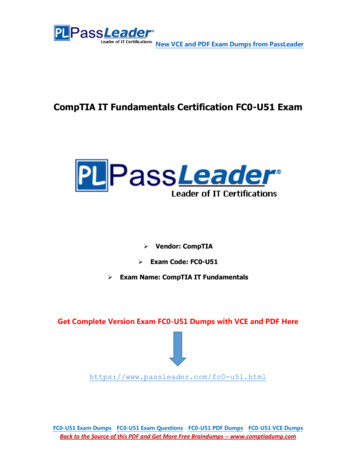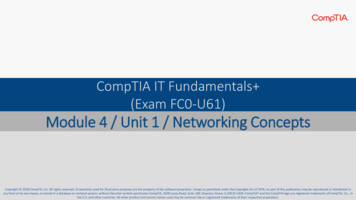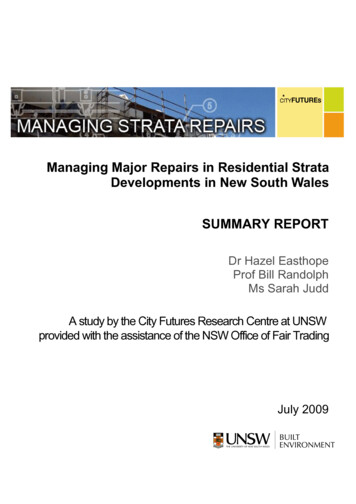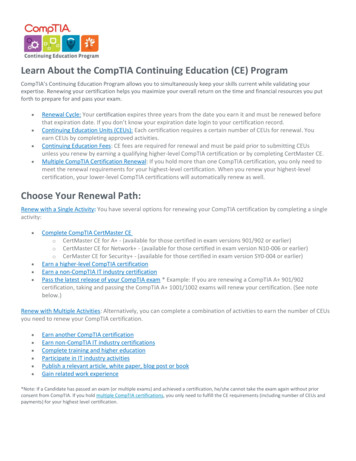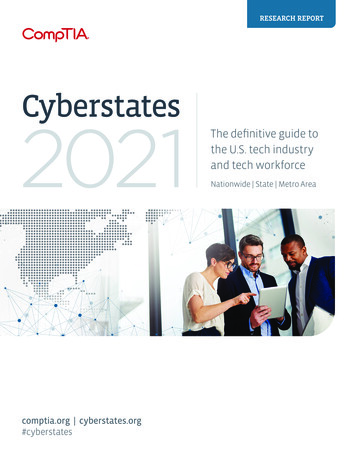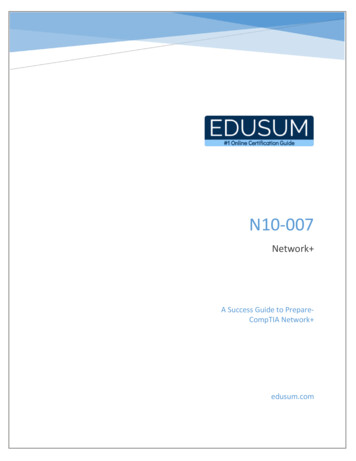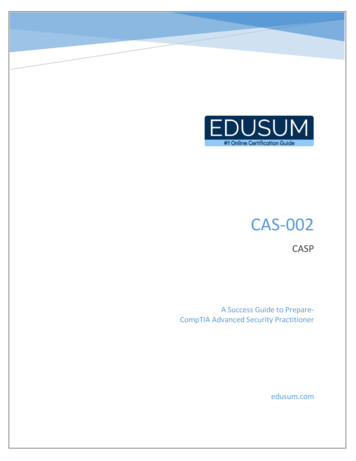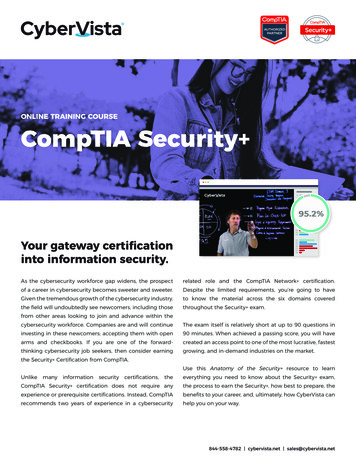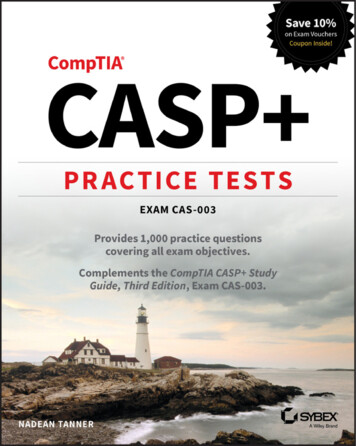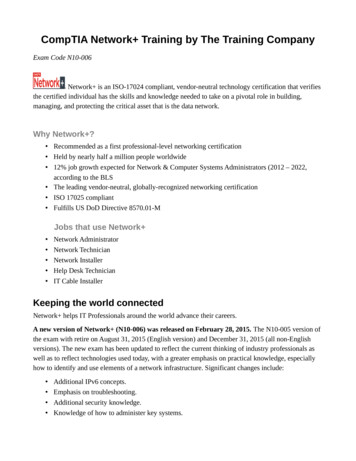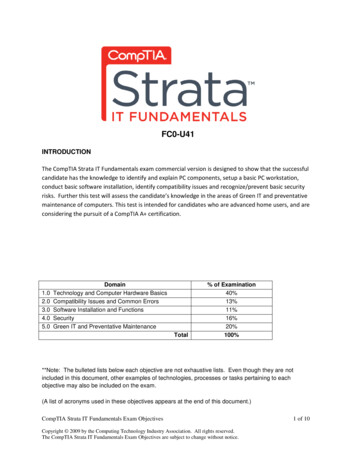
Transcription
FC0-U41INTRODUCTIONThe CompTIA Strata IT Fundamentals exam commercial version is designed to show that the successfulcandidate has the knowledge to identify and explain PC components, setup a basic PC workstation,conduct basic software installation, identify compatibility issues and recognize/prevent basic securityrisks. Further this test will assess the candidate’s knowledge in the areas of Green IT and preventativemaintenance of computers. This test is intended for candidates who are advanced home users, and areconsidering the pursuit of a CompTIA A certification.1.02.03.04.05.0DomainTechnology and Computer Hardware BasicsCompatibility Issues and Common ErrorsSoftware Installation and FunctionsSecurityGreen IT and Preventative MaintenanceTotal% of Examination40%13%11%%%16%20%100%**Note: The bulleted lists below each objective are not exhaustive lists. Even though they are notincluded in this document, other examples of technologies, processes or tasks pertaining to eachobjective may also be included on the exam.(A list of acronyms used in these objectives appears at the end of this document.)CompTIA Strata IT Fundamentals Exam ObjectivesCopyright 2009 by the Computing Technology Industry Association. All rights reserved.The CompTIA Strata IT Fundamentals Exam Objectives are subject to change without notice.1 of 10
1.0 Technology and Computer Hardware Basics1.1 Identify basic IT vocabulary. Processor speed/coreso Single/Dual/Quad coreo Intel based / Cell based/AMD basedo GHz vs. MHzo Processor cache sizeo Bus speed (as they relate to motherboards, memory, etc) RAMo DDR, DDR2, DDR3o DIMMS vs. SODIMMS Hard driveso RPMso Cache sizeo Flash based vs. traditional hard driveso SATA, SCSI, IDEo Internal vs. externalo Local vs. network shares Networkingo Wireless networking terms 802.11a/b/g/n Bluetooth RF (Radio Frequency) Interference WAP (Wireless Access Point) SSID Wireless routero Ethernet technologies CAT5 connections and cables Home plug (Ethernet over Power) Broadband router DSL and cable modems Standard vs. crossover cables Auto-negotiating (speed and duplex)o Internet Protocols HTTP vs. HTTPS FTP SSL POP3 SMTP IMAP DNS DHCP TCP/IP (IPv4 address, IPv6 address) Browser features Plug-ins Customization (text sizes, text styles, etc)CompTIA Strata IT Fundamentals Exam ObjectivesCopyright 2009 by the Computing Technology Industry Association. All rights reserved.The CompTIA Strata IT Fundamentals Exam Objectives are subject to change without notice.2 of 10
Anti-phishing featuresActiveX and JavaCookiesInternet Cache1.2 Demonstrate the proper use of the following devices: Monitorso Adjust monitor settings (brightness, contrast, etc) Desktop Server Portableo Laptopo PDAo Smartphoneo Netbook1.3 Explain the characteristics and functions of internal and external storage devices CD/CD-RW Drive DVD/DVD-RW Drive Blu-Ray Disk Drive USB storage (solid state vs. magnetic disk) Multi-card reader and writer Hard drives Mobile media devices (e.g. MP3 player or PDAs)1.4 Explain the characteristics and functions of peripheral devices Digital camera Web camera Speaker Tuner Microphone Printer / scanner1.5 Explain the characteristics and functions of core input devices Keyboard Mouse Tablet (touch screen) Numeric keypad Gamepad1.6 Identify the risks associated with upgrading the following technologies and equipment. Operating systems (open source and commercial)o Compatibility issueso Upgrade issueso Data loss PC Speed/storage capabilityo Compatibility issueso Upgrade issuesCompTIA Strata IT Fundamentals Exam ObjectivesCopyright 2009 by the Computing Technology Industry Association. All rights reserved.The CompTIA Strata IT Fundamentals Exam Objectives are subject to change without notice.3 of 10
o Bus differenceso Hardware failureApplicationo Minimum requirementso Compatibility issuesBandwidth and contentiono VoIPo Streamingo Web delivered servicesAutomatic application and operating system updateso Risks of automatic updateso Risks of not using automatic updateso Risks of not using manufacturer websites1.7 Demonstrate the ability to set up a basic PC workstation Identify differences between connector typeso DVI, VGA, HDMIo USB, PS/2o FireWireo Bluetooth and Wirelesso Serialo Network connectorso PCMCIAo ExpressCardo 3.5mm audio jacko Power connectors Monitor types Computer (desktop, tower, laptop, custom cases) Keyboard (keyboard layout: regionalization) Mouse (touchpad, optical, trackball) Printer (USB, wireless, networked) Voltage and power requirements Turn on and use the PC and peripherals2.0 Compatibility Issues and Common Errors2.1 Identify basic compatibility issues between: Processor performance RAM memory USB (1.1, 2.0) FireWire PS/2 Ethernet Wireless networks2.2 Recognize common operational problems caused by hardware Critical error message or crash System lockup (freeze) Application will not start or loadCompTIA Strata IT Fundamentals Exam ObjectivesCopyright 2009 by the Computing Technology Industry Association. All rights reserved.The CompTIA Strata IT Fundamentals Exam Objectives are subject to change without notice.4 of 10
Cannot logon to networkDriver / hardware compatibilityInput device will not function2.3 Demonstrate the ability to minimize risks Data loss Loss of service Damage to equipment3.0 Software Installation and Functions3.1 Conduct basic software installation, removal and/or upgrading. Follow basic installation/upgrade procedureso Check PC meets minimum requirementso Administrative Rightso Firewall access (unblocking ports for proper functionality) Configure the Operating Systemo Adjust basic settings (e.g. volume, date, time, time zone)o User accountso Power settings (power save, sleep mode, etc)o Screen resolutions Documentationo Licensing (Commercial, Freeware, Shareware)o Software registration Digital Rights Management Software removal (clean un-installation) Re-installation (clean installation)3.2 Identify issues related to folder and file management Create, delete, rename and move folderso Assign folder structure during installation Create, delete, rename, move and print files Importance of following back-up guidelines and procedures3.3 Explain the function and purpose of software tools Performance and error correction tools Activity or event logging Back-up tools Disk clean-up tools File compression tools4.0 Security4.1 Recognize basic security risks and procedures to prevent them. Identify Riskso Social Engineeringo Viruseso Wormso Trojan HorsesCompTIA Strata IT Fundamentals Exam ObjectivesCopyright 2009 by the Computing Technology Industry Association. All rights reserved.The CompTIA Strata IT Fundamentals Exam Objectives are subject to change without notice.5 of 10
o Unauthorized Access Hackers Phishing Spyware Adware Malware Identity Fraudo File and folder sharingo Web browser riskso Operating System vulnerability Service packs Security updateso Thefto Open or free networksIdentify prevention methodso User awareness/educationo Anti-virus softwareo Ensure proper security certificate are used (SSL)o Wireless encryption (WPA/WEP)o Anti-spywareo File encryptiono Firewallso Anti-spam softwareo Password best practice Complexity (password construction) Password confidentiality Change frequency Re-use UtilizationIdentify access control methodso Passwords and User IDo Screensaverso Physical security of hardwareo Lockso Parental controlso Smart cardo Fingerprint readero One time passwordIdentify security threats related to the following:o Media used for backup (theft or loss)o Screen visibility (shoulder surfing)o Cookies (can be stolen, stores passwords, browser tracking)o Pop-ups (automatic installations, click on links to malware)o Accidental mis-configuration4.2 Recognize security breaches and ways to resolve them. Recognize the proper diagnostic procedures when infected with a viruso Run anti-virus scano Quarantine virus when possibleo Escalate to IT professional when neededCompTIA Strata IT Fundamentals Exam ObjectivesCopyright 2009 by the Computing Technology Industry Association. All rights reserved.The CompTIA Strata IT Fundamentals Exam Objectives are subject to change without notice.6 of 10
Recognize the proper procedures to maintain a secure environmento Regular antivirus and malware scanso Application / operating system updates5.0 Green IT and Preventative Maintenance5.1 Identify environmentally sound techniques to preserve power and dispose of materials. Environmentally hazardous substance disposalo Battery disposalo CRT disposal-replace with LCDso Recycling of computers for reuse or partso Toner disposalo Cleaning supply disposalo Materials that meet RoHS guidelines Power management ( Power saving features)o Shutdown/power off procedures/policies at end of dayo Automatic power off after 15 minutes of non-useo Shutdown scripts Power management PCs and lower power servers replace large desktops with energy efficientlaptops and thin clients5.2 Identify green techniques, equipment and procedures. Define Cloud computingo Define Virtualization (Have more than one server running on a single piece of hardware)o Reduced power and cooling consumption Duplex printing and use lower cost per page network printers Terminal Servers Energy Star rating Use low power NAS (network attached storage) instead of file servers Employee telecommutingo Reduced emissionso Reduced office space heating, lighting, etc Solid State drives Define VoIP and how it relates to Green IT Green building infrastructureo Eliminate cool air leaks in server roomso Proper spacing for cooling IT equipmento Energy efficient cooling fans-BIOS adjustable5.3 Identify preventative maintenance products, techniques, and how to use them. Liquid cleaning compounds Types of materials to clean contacts and connections Compressed air Cleaning monitors Cleaning removable media devices Ventilation, dust and moisture control on the PC hardware interior Surge suppressors Use of ESD equipmentCompTIA Strata IT Fundamentals Exam ObjectivesCopyright 2009 by the Computing Technology Industry Association. All rights reserved.The CompTIA Strata IT Fundamentals Exam Objectives are subject to change without notice.7 of 10
Wire placement and safetyCompTIA Strata AcronymsCompTIA Strata IT Fundamentals Exam ObjectivesCopyright 2009 by the Computing Technology Industry Association. All rights reserved.The CompTIA Strata IT Fundamentals Exam Objectives are subject to change without notice.8 of 10
IntroductionThe following is a list of acronyms which appear on the CompTIA Strata tests. Candidates are encouraged toreview the complete list and attain a working knowledge of all listed acronyms as a part of a comprehensive testpreparation R RAMDDR IPSPELLED OUTalternating currentaccelerated graphics portbasic input/output systemcompact disccompact disc-read-only memorycompact disc-rewritablecentral processing unitcathode-ray tubedirect currentdouble data-ratedouble data-rate random access memorydouble data-rate synchronous dynamic random access memorydynamic host configuration protocoldual inline memory moduledomain name service or domain name serverdigital subscriber linedigital video disc or digital versatile discdigital video disc-random access memorydigital video disc-read only memorydigital video disc-recordabledigital video disc-rewritabledigital visual interfaceelectromagnetic interferenceelectromagnetic pulseelectrostatic dischargefile allocation table32-bit file allocation tablefloppy disk drivegigabitgigabytegigahertzhard disk drivehigh definition media interfacehypertext markup languagehypertext transfer protocolhypertext transfer protocol over secure sockets layerintegrated drive electronicsinternet protocolCompTIA Strata IT Fundamentals Exam ObjectivesCopyright 2009 by the Computing Technology Industry Association. All rights reserved.The CompTIA Strata IT Fundamentals Exam Objectives are subject to change without notice.9 of 10
MCIAPDARAMRJRJ-11RJ-45SATASCSISD FIWPAinfraredintegrated services digital networkkilobitKilobyte or knowledge baselocal area networkmegabitmegabytemegahertzMoving Picture Experts Group Layer 3 AudioMoving Picture Experts Group Layer 4Moving Picture Experts Groupnetwork interface cardoperating systempersonal computerperipheral component interconnectperipheral component interconnect expressperipheral component interconnect extendedPersonal Computer Memory Card International Associationpersonal digital assistantrandom access memoryregistered jackregistered jack function 11registered jack function 45serial advanced technology attachmentsmall computer system interfacesecure digital cardsmall office/home officeservice set identifiersecure sockets layerterabytetransmission control protocoltransmission control protocol/internet protocoluninterruptible power supplyuniform resource locatoruniversal serial busvideo graphics arrayvoice over internet protocolwireless application protocolwired equivalent privacywireless fidelitywireless protected accessCompTIA Strata IT Fundamentals Exam ObjectivesCopyright 2009 by the Computing Technology Industry Association. All rights reserved.The CompTIA Strata IT Fundamentals Exam Objectives are subject to change without notice.10 of 10
The CompTIA Strata IT Fundamentals Exam Objectives are subject to change without notice. Introduction The following is a list of acronyms which appear on the CompTIA Strata tests. Candidates are encouraged to review the complete list and attain a working knowledge of all listed acronyms as a part of a comprehensive test
